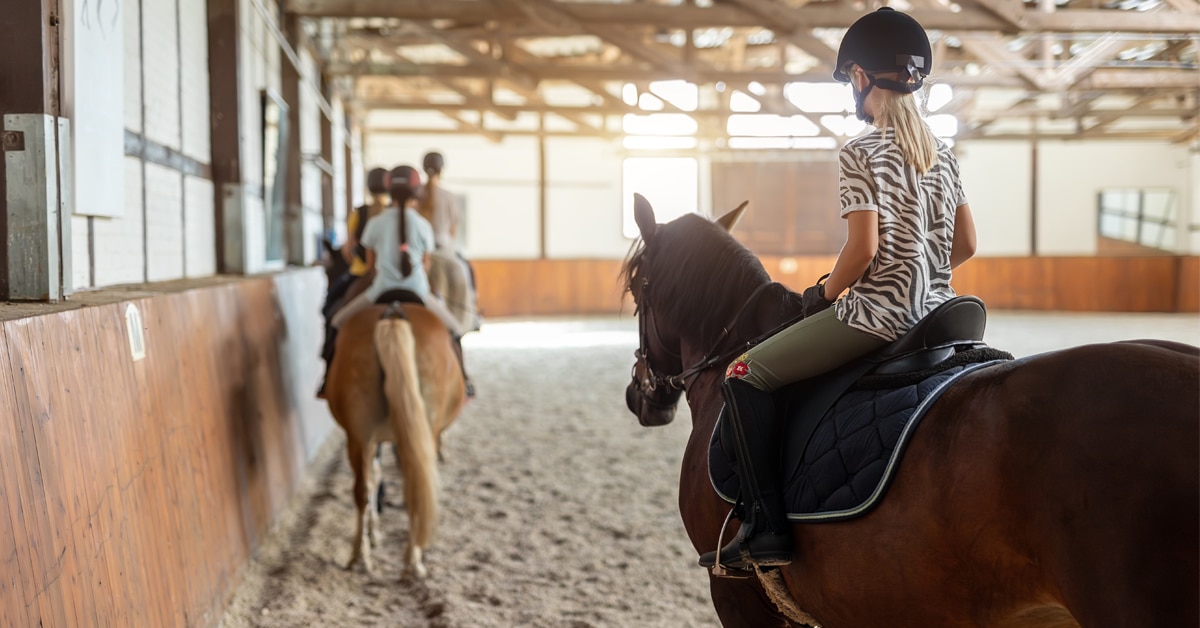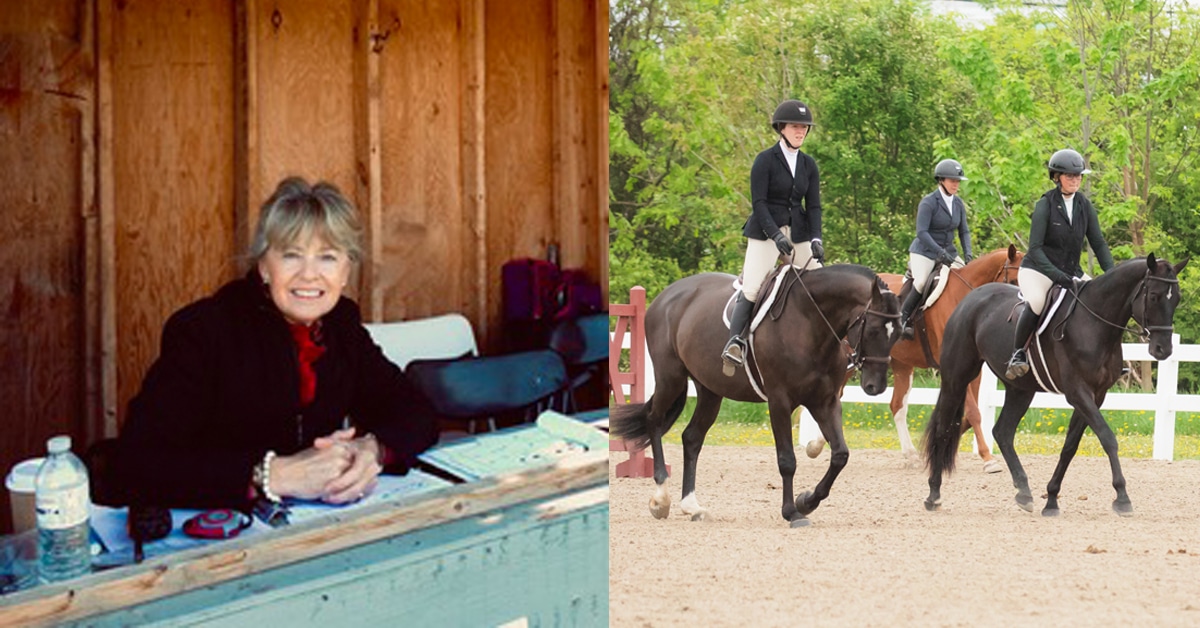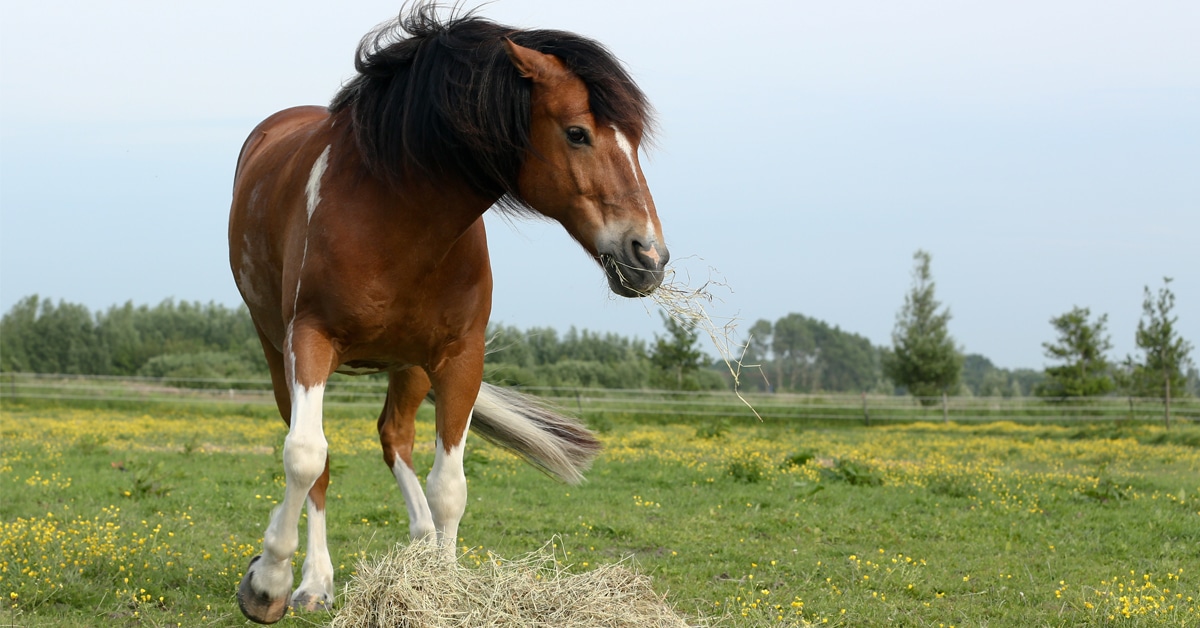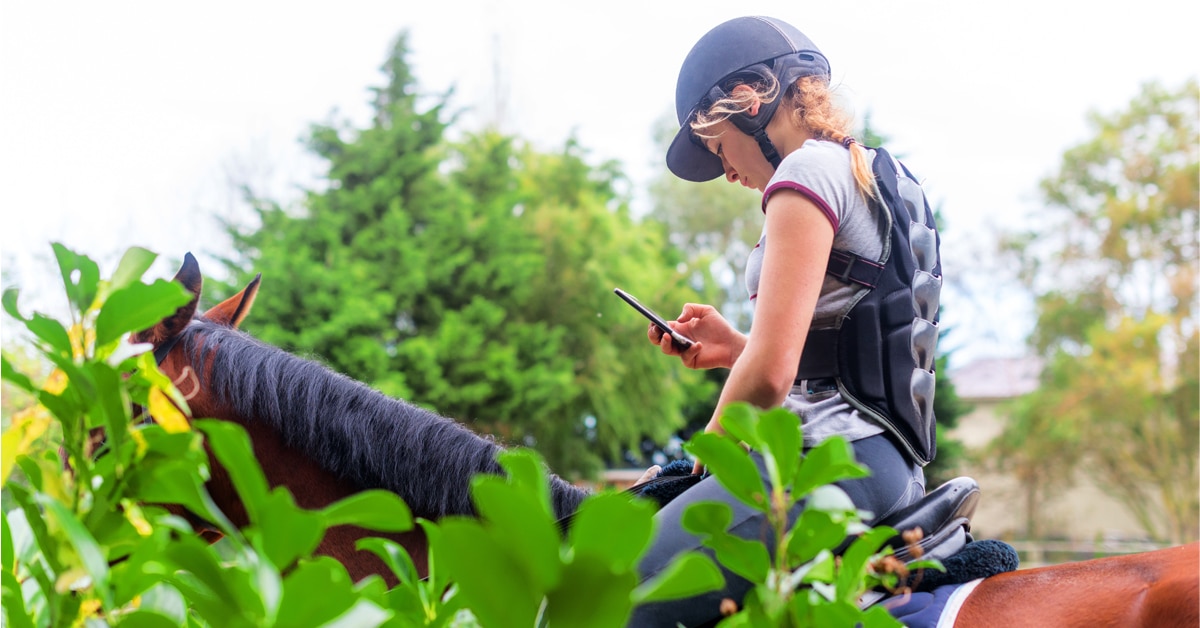In order to build muscle we have to tear some down first. Tiny micro tears in the fibers lead to growth of new muscle. This process is painful as is evident by the soreness we feel the day or two after a tough workout. The same process occurs in our horses as they work and become stronger and fitter. But what happens when the stiffness and soreness happen too soon, immediately after exercise or even during a training session? This abnormality is known as exertional rhabdomyolysis (ER) and while it can be a one-time occurrence, certain horses are predisposed to repeated events warranting diagnostic investigation and a diet and exercise program to prevent future episodes.
While ER has been called many different names; Monday Morning Disease, azoturia and set fast, the signs of tying up are the same and easily recognizable. Typically occurring within 15-30 minutes of exercise, horses become stiff and have a short strided, stilted gait, cramping, muscle fasciculation, anxiety (sweating, tachycardia) refusal to move and sometimes recumbency. Signs are mainly limited to the muscles of the hindquarters (gluteal and quadraceps) but the front limbs may also be affected. Muscles are firm and painful on palpation. Severe acute cases may appear to show signs that can be confused with colic, acting agitated and stretching out as if to urinate.
Initial diagnosis of an episode of tying up is based on clinical signs and the demonstration of muscle damage. As the large muscles of the back and rump spasm and forcibly contract, muscle cells are damaged. These cells leak out two enzymes that can be measured in the blood, creatine kinase (CK) and aspartate transaminase (AST).
ELEVATED ENZYMES
Elevations in these enzymes can tell you that an episode of tying up has occurred and can help you estimate whether the muscle damage is a single acute event or is ongoing. CK begins to increase within hours of muscle damage and is a very sensitive indicator of the degree of insult. Small changes in CK can be seen with normal activities like training or even trailering. Large changes can be seen with strenuous exercise (without tying up). In episodes of rhabdomyolysis we see elevations that are hundreds to a thousand times the normal range. CK will also dissipate as rapidly as it rises, peaking at 24 hours post-insult before it begins to drop. If elevated CK is seen for several days following the initial episode, this indicates that muscle damage is ongoing. AST increases more slowly than CK and remains in the bloodstream for longer. Elevated levels of AST combined with elevated levels of CK are consistent with recent muscle damage. If there is no longer any ongoing muscle damage the CK levels should rapidly decrease over 24-48 hours while AST levels will take 4-7 days to return to normal.
When treating an episode of tying up it is most important to stop all forced exercise as soon as the signs are recognized. Encouraging the horse to keep working or even walking will only exacerbate the muscle damage and worsen the episode. These horses respond well to anti-inflammatory medications such as phenylbutazone or flunixin meglumine (Banamine) and will also derive pain relief from muscle relaxers such as methocarbomol (Robaxin). Maintaining adequate hydration after an episode is also extremely important. In addition to CK and AST, the damaged muscle fibers leak myoglobin into the circulatory system. This molecule is darkly pigmented and is filtered through the kidneys in order to be excreted. The pigment in the myoglobin will cause the urine to turn a dark red to brown color. This pigment is also extremely toxic to the kidney and severe cases of tying up can lead to acute renal failure. There does not have to be pigmenturia (discolored urine) for there to be renal damage but the more pigment seen in the urine the greater the risk. Tying up is rarely fatal but the subsequent renal disease can be. Quickly flushing the myoglobin from the system will protect the kidneys from damage. Providing electrolytes to encourage water intake is advisable and if dark urine is observed your veterinarian can administer intravenous fluids to clear the pigment.
Although the signs and initial treatments are the same for every episode of tying up, the causes can be very different from horse to horse and the exact reason for the episode can tell you if your horse is likely to have this happen again. Understanding the causes of tying up and taking the steps needed to make a diagnosis will help you determine why your horse is tying up, how this will affect their athletic career and if they could pass these traits on to their offspring. It will also aid your development of a nutritional and exercise program for your horse to prevent future episodes.
SPORADIC TYING UP
Random occurrences of tying up happen for a different set of reasons than chronic cases. The most common cause of sporadic tying-up is an exercise session that far exceeds the horse’s fitness level. Horses that are only intermittently ridden or are being progressed through a training program too quickly and horses competing at high level events without proper conditioning are prone to single episodes of ER. Adhering to a consistent and appropriate exercise regime is the best way to prevent recurrence of ER. Horses usually recover easily with rest and limited exercise (paddock turnout) until the muscle enzymes (CK and AST) return to normal.
Electrolyte imbalances that accompany strenuous exercise can cause ER. Sodium, potassium, calcium and magnesium are lost through sweat and all play a major roll in muscle contractility. Simple electrolyte supplementation before and after strenuous exercise will keep electrolyte levels within the normal range. Horses with undiagnosed lamenesses are more prone to ER due to a shift in balance and muscle strain. The incidence of tying up also increases in the face of upper respiratory disease, both equine herpes virus (EHV) and equine influenza. It is important to consider general health (as well as the health of your stable mates) when assessing a horse that has tied up so do not skip a general physical examination and lameness evaluation as part of your diagnostics.
Horses that are on a high sugar and starch grain diet are also known to experience episodes of ER but in most cases this is due to an underlying chronic condition (see pp 42).
Stop all forced exercise as soon as the signs are recognized. Encouraging the horse to keep working or even walking will only exacerbate the muscle damage and worsen the episode.
CHRONIC TYING UP
Recurrent Exertional Rhabdomyolysis (RER) is one of the most common muscle disorders in horses, affecting over 10% of Thoroughbred racehorses with 75% of these horses having monthly episodes of tying-up. There is a genetic component to this disease, though the exact gene has yet to be identified. Susceptible horses that are high-strung, female, on a high volume sweet feed diet or concurrently lame are more likely to have repeated episodes of tying up.
Prevention of RER involves a standardized daily routine and environment that minimizes stress. Consistent exercise is essential. Even when these horses are recovering from an episode of tying up daily turnout should be provided. The diet should be adjusted to include high quality hay and low sugar/starch grain. Fat supplementation can provide extra energy (and maintain weight) for athletes without increasing their carbohydrate intake. Two medications have been shown to prevent episodes of RER, dantrolene and phenytoin, however their long term effectiveness has not been proven and they are very expensive.
Polysaccharide Storage Myopathy (PSSM) is a result of accumulation of abnormal polysaccharide, long chain carbohydrates. This genetic defect has been identified in over 20 breeds in North America and Europe. The most common breeds affected are Quarter Horses, drafts and warmbloods.
Horses diagnosed with PSSM do well when they are maintained at a good level of fitness. Exercise intensity should be increased slowly and affected animals may benefit from living in a field where they can move freely. PSSM cases should be fed a high fat (13% of total), low carbohydrate (less than 10% of total) diet. Many feeds are available now that provide adequate calories in the form of fat with low levels of sugar/starch. These horses should also be fed a hay with less than 12% non-structured carbohydrate. The only way to know the NSC content of your hay is to have it tested.
It is important that each episode of tying up is managed promptly and properly but in order to prevent future events more advanced diagnostics must be employed. When managing a horse that has a history of tying up review your conditioning program, ensure adequate electrolyte supplementation and monitor for any signs of illness or lameness. While general care for these horses is very similar, combining consistent exercise with a low carbohydrate, high fat diet, muscle biopsies and genetic testing can elucidate the exact cause behind the rhabdomyolysis allowing you to tailor a plan specific to your own horse.
Affected animals may benefit from living in a field where they can move freely.
Tying up is rarely fatal but the subsequent renal disease can be. Quickly flushing the myoglobin from the system will protect the kidneys from damage.
Hyperkalemic Periodic Paralysis (HYPP)
One cannot discuss muscle disease in horses without mentioning Hyperkalemic Periodic Paralysis (HYPP), arguably the most well know myopathy in equine medicine. HYPP is caused by a mutation passed on by the Quarter Horse stallion “Impressive” and subsequent descendants. Episodes are characterized by myotonia (sustained muscle contraction) and paresis. HYPP is not classified as tying up because it is not always associated with exercise but can occur after travel, feeding high potassium feeds or a stressful event. Additionally once recovered from an HYPP attack there is no muscle soreness or stiffness, whereas horses who have tied up will remain stiff and sore for days to a week after tying up.
The Latest










